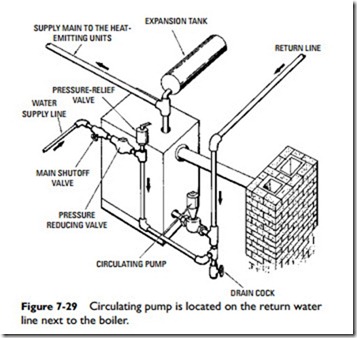Circulating Pumps (Circulators)
In forced-hot-water heating systems, circulating pumps (also some- times called circulators or booster pumps) are used to force the hot water through the piping or tubing. Figure 7-29 illustrates a typical location of one of these pumps on a return line. The operation of
the one or more circulating pumps in a hydronic system is con- trolled by a circulator relay.
Circulating pumps for hot-water heating systems are designed and built to handle a wide range of pumping capacities. They will vary in size from small booster pumps with a 5-gpm capacity to those capable of handling thousands of gallons per minute. Some are field serviceable with replaceable cartridges.
In order to select a suitable pump for a hot-water heating sys- tem (i.e., one that will produce maximum flow without overload- ing the pump motor), it is necessary to match the operating characteristics of the pump correctly to the requirements of the heating system.
The correct location of a pump is crucial to its successful operation. Pump manufacturers will usually give detailed information in their literature on this point. Circulating pumps with mechanical seals are very common in hot-water heating systems.
Drainage
There should be a provision for adequate drainage facilities in a hot-water heating system during shutdown periods. Pitching all pipes to a central point is an important consideration in designing the system because it is essential to effective drainage. If drainage is not provided for, there is always the danger of the unheated water freezing in the pipes during extreme cold weather. In most installations a manual drain cock is installed at the lowest point in the return line just before it reaches the circulating pump (see Figure 7-29). Chemical antifreeze solutions have also been developed for use in hot-water heating systems in an attempt to prevent the water from freezing during shut-down periods.
